2021-08-26 - Nº 330
Editorial
Esta é a Newsletter Nº 330 que se apresenta com o mesmo formato que as anteriores. Se gostar da Newsletter partilhe-a!
Todas as Newsletters encontram-se indexadas no link.
Esta Newsletter tem os seguintes tópicos:
Faz hoje anos que nascia, em 1728, o matemático, astrónomo, físico e filósofo suíço-alemão Johann Heinrich Lambert. Ele forneceu a primeira prova rigorosa de que pi é irracional (não pode ser expresso como o quociente de dois inteiros). Em 1766, Lambert escreveu Theorie der Parallellinien, um estudo sobre o postulado paralelo. Ao assumir que o postulado paralelo era falso, deduziu muitos resultados não-euclidianos. Ele notou que nesta nova geometria a soma dos ângulos de um triângulo aumenta à medida que a sua área diminui. Lambert conjecturou que e e p são transcendentais, embora isto não tenha sido provado durante mais um século. Ele é responsável por muitas inovações no estudo do calor e da luz, concebeu um método de medição da intensidade da luz, bem como trabalhou sobre a teoria da probabilidade.
Faz também hoje anos que nascia, em 1740, o inventor e balonista francês Joseph-Michel Montgolfier. Ele, com o seu irmão mais novo, Étienne, conduziu uma primeira experiência com um balão de tafetá cheio de fumo quente, foi presenteado com uma demonstração pública a 5 de Junho de 1783. Este trabalho pioneiro foi seguido por um voo com três animais como passageiros a 19 de Setembro de 1783, exibido em Paris e testemunhado pelo Rei Luís XVI. A 21 de Novembro de 1783, o seu balão transportou os dois primeiros homens num voo desamarrado. No espaço de um ano após o lançamento do seu balão de ensaio, os irmãos Montgolfier tinham permitido o primeiro voo tripulado de balão no mundo.
Faz igualmente hoje anos que nascia, em 1743, o químico francês Antoine Lavoisier. Ele foi considerado o "pai da química moderna", foi um brilhante experimentador também activo nos assuntos públicos. Um aristocrata, investiu numa empresa privada contratada pelo governo para cobrar impostos. Com a sua riqueza, construiu um grande laboratório. Em 1778, descobriu que o ar consiste numa mistura de dois gases a que chamou oxigénio e azoto. Ao estudar o papel do oxigénio na combustão, substituiu a teoria do clogistão. Lavoisier descobriu também a lei da conservação da massa e concebeu o método moderno de nomeação de compostos, que substituiu o método antiquado não sistemático.
Faz também hoje anos que nascia, em 1873, o inventor americano Lee de Forest. Ele inventou o tubo de vácuo Audion, que tornou possível a transmissão de rádio ao vivo e se tornou o componente chave de todos os sistemas de rádio, telefone, radar, televisão e computador antes da invenção do transístor em 1947. Detinha 300 patentes.
Faz igualmente hoje anos que nascia, em 1882, o físico germano-americano James Franck. Ele partilhou o Prémio Nobel da Física em 1925 com Gustav Hertz pela investigação sobre a excitação e ionização dos átomos por bombardeamento de electrões que verificou a natureza quantizada da transferência de energia.
Por fim, faz hoje anos que nascia, em 1951, o Físico matemático norte-americano Edward Witten. Ele foi o primeiro físico a ser reconhecido com a Medalha Fields em 1990, pelos seus trabalhos com a teoria das supercordas, quando tinha 39 anos e no Institute for Advanced Study em Princeton, Nova Jersey. A Medalha Fields é considerada como tendo o estatuto de Prémio Nobel para matemáticos. Witten já era conhecido pelas suas contribuições na teoria elementar das partículas, especialmente na teoria quântica de campo e teoria das cordas, e pelas suas implicações matemáticas, quando em 1998 recebeu o Prémio Dannie Heineman de Física Matemática. Este prémio da Sociedade Física Americana foi atribuído por "avanços na elucidação da dinâmica do campo super-simétrico fortemente acoplado e das teorias das cordas", no qual explorou "as profundas consequências físicas e matemáticas da dualidade electro-magnética".
Nesta semana que passou o Linux fez 30 anos. Passaram-se três décadas, desde que começou por ser um projecto académico de Linus Torvalds e hoje em dia é o sistema operativo mais usado no mundo. Usado em todo o tipo de dispositivos, desde os smartphones Android aos Servidores passando pelos Desktops. Tem os 100% dos TOP500 computadores mais potentes do mundo. De acordo com a Google o sistema é usado em mais de 3 mil milhões de dispositivos Android. De entre as suas façanhas, está presente e é essencial para o funcionamento da ISS e já voo em Marte para controlar o drone Ingenuity.
Na Newsletter desta semana apresentamos diversas noticias, artigos científicos, projetos de maker assim como alguns videos interessantes. É apresentada a revista MagPI Magazine nº 109 de Setembro e o livro "Learning MongoDB".
 João Alves ([email protected])
João Alves ([email protected])
O conteúdo da Newsletter encontra-se sob a licença  Creative Commons Attribution-NonCommercial-ShareAlike 4.0 International License.
Creative Commons Attribution-NonCommercial-ShareAlike 4.0 International License.
Novidades da Semana

Happy birthday, Linux: From a bedroom project to billions of devices in 30 years
"Greg Kroah-Hartman talks to El Reg about world domination, what was, and what may be for the kernel On August 25, 1991, Linus Torvalds, then a student at the University of Helsinki in Finland, sent a message to the comp.os.minix newsgroup soliciting feature suggestions for a free Unix-like operating system he was developing as a hobby. Thirty years later, that software, now known as Linux, is everywhere. It dominates the supercomputer world, with 100 per cent market share. According to Google, the Linux kernel is at the heart of more than three billion active devices running Android, the most-used operating system in the world. Linux also powers the vast majority of web-facing servers Netcraft surveyed. It is even used more than Microsoft Windows on Microsoft's own Azure cloud." [...]
Outras Notícias
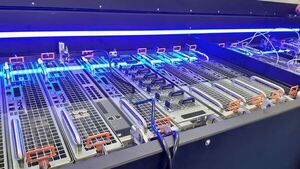
Intel and Submer Advance Data Center Cooling Tech
"Today, Intel and Submer announced a collaboration to co-develop the Precision Immersion Cooling Fluid Cloud for use in next-generation data centers. Intel and Submer are using Intel Xeon-based immersion-optimized server boards and Submer’s precision cooling technique to demonstrate the reuse of high-grade waste heat generated by compute elements in data centers. Intel and Submer’s collaboration will help accelerate industry standards for the adoption of immersion cooling. "Recent innovations in immersion cooling techniques are helping to significantly improve the energy efficiency of data centers and enable organizations to address their sustainability goals. Our collaboration with Submer will allow us to address all stages of the immersion cooling value chain and offer a sustainable solution that will make a difference for our mutual customers." –Mohan Kumar, Intel Fellow in the Datacenter and AI Group Data center managers are increasingly looking for ways to implement greener and more sustainable designs." [...]

NVIDIA Turbocharges Extreme-Scale AI for Argonne National Laboratory’s Polaris Supercomputer
"Largest GPU-Powered Supercomputer for U.S. Department of Energy’s Argonne Lab Will Enable Scientific Breakthroughs in Era of Exascale AI The largest GPU-based supercomputer at the U.S. Department of Energy’s Argonne National Laboratory will run on NVIDIA’s accelerated computing platform, the company announced today. The Polaris supercomputer, hosted at the laboratory’s Argonne Leadership Computing Facility (ALCF), will supercharge research and discovery with extreme scale for users’ algorithms and science. Accelerated by 2,240 NVIDIA® A100 Tensor Core GPUs, the system can achieve almost 1.4 exaflops of theoretical AI performance and approximately 44 petaflops of peak double-precision performance. Polaris, to be built by Hewlett Packard Enterprise, will combine simulation and machine learning by tackling data-intensive and AI high performance computing workloads, powered by 560 total nodes, each with four NVIDIA A100 GPUs. “The era of exascale AI will enable scientific breakthroughs with massive scale to bring incredible benefits for society,” said Ian Buck, vice president and general manager of Accelerated Computing at NVIDIA. “NVIDIA’s GPU-accelerated computing platform provides pioneers like the ALCF breakthrough performance for next-generation supercomputers such as Polaris that let researchers push the boundaries of scientific exploration.” “Polaris is a powerful platform that will allow our users to enter the era of exascale AI,” said ALCF Director Michael E. Papka." [...]

Samsung Brings In-Memory Processing Power to Wider Range of Applications
"ntegration of HBM-PIM with the Xilinx Alveo AI accelerator system will boost overall system performance by 2.5X while reducing energy consumption by more than 60% PIM architecture will be broadly deployed beyond HBM, to include mainstream DRAM modules and mobile memory Samsung Electronics, the world leader in advanced memory technology, today showcased its latest advancements with processing-in-memory (PIM) technology at Hot Chips 33—a leading semiconductor conference where the most notable microprocessor and IC innovations are unveiled each year. Samsung’s revelations include the first successful integration of its PIM-enabled High Bandwidth Memory (HBM-PIM) into a commercialized accelerator system, and broadened PIM applications to embrace DRAM modules and mobile memory, in accelerating the move toward the convergence of memory and logic. First Integration of HBM-PIM Into an AI Accelerator In February, Samsung introduced the industry’s first HBM-PIM (Aquabolt-XL), which incorporates the AI processing function into Samsung’s HBM2 Aquabolt, to enhance high-speed data processing in supercomputers and AI applications. The HBM-PIM has since been tested in the Xilinx Virtex Ultrascale+ (Alveo) AI accelerator, where it delivered an almost 2.5X system performance gain as well as more than a 60% cut in energy consumption. “HBM-PIM is the industry’s first AI-tailored memory solution being tested in customer AI-accelerator systems, demonstrating tremendous commercial potential,” said Nam Sung Kim, senior vice president of DRAM Product & Technology at Samsung Electronics. “Through standardization of the technology, applications will become numerous, expanding into HBM3 for next-generation supercomputers and AI applications, and even into mobile memory for on-device AI as well as for memory modules used in data centers.” “Xilinx has been collaborating with Samsung Electronics to enable high-performance solutions for data center, networking and real-time signal processing applications starting with the Virtex UltraScale+ HBM family, and recently introduced our new and exciting Versal HBM series products,” said Arun Varadarajan Rajagopal, senior director, Product Planning at Xilinx, Inc. “We are delighted to continue this collaboration with Samsung as we help to evaluate HBM-PIM systems for their potential to achieve major performance and energy-efficiency gains in AI applications.” DRAM Modules Powered by PIM The Acceleration DIMM (AXDIMM) brings processing to the DRAM module itself, minimizing large data movement between the CPU and DRAM to boost the energy efficiency of AI accelerator systems." [...]

IBM Unveils On-Chip Accelerated Artificial Intelligence Processor
"At the annual Hot Chips conference, IBM (NYSE: IBM) today unveiled details of the upcoming new IBM Telum Processor, designed to bring deep learning inference to enterprise workloads to help address fraud in real-time. Telum is IBM's first processor that contains on-chip acceleration for AI inferencing while a transaction is taking place. Three years in development, the breakthrough of this new on-chip hardware acceleration is designed to help customers achieve business insights at scale across banking, finance, trading, insurance applications and customer interactions. A Telum-based system is planned for the first half of 2022. Innovations across banking, finance, trading, insurance Today, businesses typically apply detection techniques to catch fraud after it occurs, a process that can be time consuming and compute-intensive due to the limitations of today's technology, particularly when fraud analysis and detection is conducted far away from mission critical transactions and data. Due to latency requirements, complex fraud detection often cannot be completed in real-time – meaning a bad actor could have already successfully purchased goods with a stolen credit card before the retailer is aware fraud has taken place." [...]

Analog Devices Completes Acquisition of Maxim Integrated
"Analog Devices, Inc. (NASDAQ: ADI) today announced the completion of its previously announced acquisition of Maxim Integrated Products, Inc. (NASDAQ: MXIM). The combination further strengthens ADI’s position as a high-performance analog semiconductor company with trailing twelve-month revenue of over $9 billion1, industry leading margins, and free cash flow of over $3 billion1 on a pro forma basis. “Today is a tremendous milestone for ADI and I’m delighted to welcome the Maxim team, who share our passion for solving our customers’ most complex technology problems,” said Vincent Roche, President and CEO. “With more than 10,000 engineers and the increased breadth and depth of our best-in-class technologies, we are well-positioned to develop even more complete, cutting-edge solutions for our customers. Together, we will drive the next waves of analog semiconductor innovation, while engineering a healthier, safer and more sustainable future for all.” Under the terms of the definitive agreement, Maxim stockholders received 0.63 of a share of ADI common stock for each share of Maxim common stock. Maxim common stock will no longer be listed for trading on the NASDAQ stock market." [...]
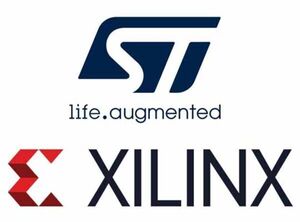
STMicroelectronics Collaborates with Xilinx to Power Radiation-Hardened FPGAs using ST Space-Qualified Regulators
"STMicroelectronics (NYSE: STM), a global semiconductor leader serving customers across the spectrum of electronics applications, announced it is collaborating with Xilinx, Inc. to build a power solution for the Xilinx Kintex® UltraScale™ XQRKU060 radiation-tolerant FPGA, leveraging QML-V qualified voltage regulators from ST’s space-products portfolio. The programmability of the Xilinx XQRKU060 revolutionizes the economics of equipment like space-research instruments and commercial satellites. The device delivers a combination of high compute density and integration that historically required an application-specific IC (ASIC), which typically involves custom design with associated engineering expenses and turnaround time. Unlike an ASIC, the XQRKU060 FPGA can be reconfigured in orbit, allowing bug fixes and updates to be applied cost-effectively at any time to protect the mission. ST worked closely with Xilinx to design a power source that ensures reliable operation of the XQRKU060 by providing excellent fixed-point voltage accuracy as well as stability in the event of transients due to normal FPGA operation and radiation events. The solution uses ST’s RHRPMPOL01 rad-hard point of load 7A monolithic synchronous step-down regulator and RHFL6000A linear voltage regulator, all SEL immune and QML-V qualified." [...]
Renesas and Dialog Semiconductor Announce Conclusion of Final Regulatory Review and the Expected Closing Date for Renesas’ Proposed Acquisition of Dialog Semiconductor
"Renesas Electronics Corporation (TSE: 6723, “Renesas”), a premier supplier of advanced semiconductor solutions, and Dialog Semiconductor Plc (XETRA:DLG, “Dialog Semiconductor”), a leading provider of battery and power management, Wi-Fi, Bluetooth® low energy (BLE) and Industrial edge computing solutions, are pleased to announce that the Taiwan Fair Trade Commission has waived its jurisdiction to review the recommended all-cash acquisition of Dialog Semiconductor by Renesas. The relevant authorities in Germany, the People’s Republic of China and the United States have already issued the anti-trust and/or foreign investment clearances, have allowed the applicable waiting period to expire or have waived jurisdiction, as appropriate. At the Dialog General Meeting and at the Court Meeting held on April 9, 2021, all resolutions proposed in connection with the Scheme were duly passed by the requisite majorities and, accordingly, the Acquisition has been approved by Dialog Shareholders. The Scheme remains subject to the satisfaction or (if capable of waiver) waiver of certain remaining Conditions set out in the Scheme Document, including the Court’s sanction of the Scheme at the Court Sanction Hearing and the delivery of the Court Order to the Registrar of Companies. The current expected timetable of principal events for the implementation of the Scheme is set out in the announcement published jointly by Renesas and Dialog Semiconductor earlier today via a Regulatory Information Service. In particular, please note that the Court Sanction Hearing has been scheduled for August 27, 2021 (London time) and the closing date of the Acquisition is expected to be on August 30, 2021 (London time), August 31, 2021 (JST)." [...]
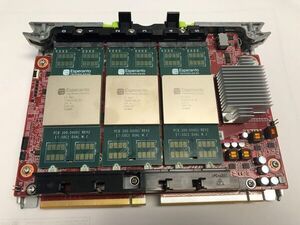
Esperanto Technologies Unveils Energy-Efficient RISC-V-Based Machine Learning Accelerator Chip At Hot Chips 33 Conference
"Esperanto Technologies™, a developer of high-performance, energy-efficient machine learning (ML) inference accelerators based on the RISC-V instruction set, today announced that company founder and executive chairman Dave Ditzel will reveal new details of the company’s new ET-SoC-1 “supercomputer-on-a-chip” at the Hot Chips 33 conference on August 24, 2021, at 8:30 AM Pacific time. Featuring over a thousand RISC-V custom processor cores, Esperanto’s ML inference accelerator is designed to be the highest performance commercial RISC-V chip. Designed to meet the high-performance but still air-cooled, low-power requirements of large-scale datacenter customers, Esperanto’s RISC-V-based inference chip is a general purpose, parallel processing solution that can accelerate many parallelizable workloads. The Esperanto chip is designed to operate at under 20 watts in order to fit within enterprise customers’ demanding system power constraints. The chip includes over a thousand energy-efficient RISC-V, ET-Minion™ processor cores each with its own custom vector / tensor unit, four high performance out-of-order RISC-V, ET-Maxion™ processor cores, and a high-performance memory system. The Esperanto chip is designed to excel at machine learning recommendation models, one of the most important types of AI workloads in many large datacenters." [...]

OneWeb Confirms Another Successful Launch, Accelerating Business Momentum
"OneWeb, the low Earth orbit (LEO) satellite communications company, today confirmed the next successful launch of 34 satellites by Arianespace from the Baikonur Cosmodrome. The launch follows the successful completion of OneWeb’s ‘Five to 50’ mission and highlights the momentum of the business as it prepares to both introduce commercial service and focus on scaling to global service. This latest successful launch brings OneWeb’s total in-orbit constellation to 288 satellites. These will form part of OneWeb’s 648 LEO satellite fleet that will deliver high-speed, low-latency global connectivity. Lift-off occurred on 21 August at 23:13 BST. OneWeb’s satellites separated from the rocket and were dispensed in nine batches over a period of three hours 45 minutes with signal acquisition on all 34 satellites confirmed." [...]
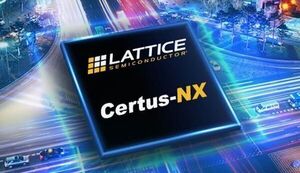
Lattice Certus-NX FPGAs Optimized for Automotive Applications
"Best-in-class High I/O Density, Small Form Factor General Purpose FPGAs Based on Lattice Nexus Platform Now AEC-Q100 Qualified Lattice Semiconductor (NASDAQ: LSCC), the low power programmable leader, today expanded its growing portfolio of automotive products with the announcement of versions of the Lattice Certus™-NX FPGA family optimized for infotainment, advanced driver assistance systems (ADAS), and safety-focused applications. Built on the Lattice Nexus™ platform, these new Certus-NX devices combine automotive-grade features with best-in-class I/O density, power efficiency, small size, reliability, instant-on performance, and support for fast PCI Express (PCIe) and Gigabit Ethernet interfaces. “Demand for automotive semiconductors is increasing as the ongoing trends towards automotive system electrification, autonomy, and connectivity have manufacturers looking for ways to deliver the advanced features and user experiences drivers are looking for in their next vehicle,” said Jay Aggarwal, Director of Silicon Product Marketing, Lattice Semiconductor. “With class-leading performance and power efficiency, support for popular I/O standards in a small form factor, and high reliability, our Certus-NX general purpose FPGAs make a compelling silicon platform for the next-generation automotive applications car makers are eager to provide to their customers.” “As more automotive systems go digital, modern cars have essentially become mobile datacenters. Automotive developers need access to secure and reliable silicon solutions with fast I/O performance to ensure mission-critical automotive systems can perform their functions instantaneously,” said K. Ganesh Rao, Practice Head – FPGA Solutions, Tata Elxsi. “Lattice Certus-NX FPGAs provide the reliability, performance, and feature set we need to make tomorrow’s automotive applications possible.” The latest Certus-NX FPGAs are ideal for automotive applications like motor control, LED control in in-vehicle infotainment (IVI) systems, in-vehicle networking (IVN), and sensor data co-processing in ADAS applications." [...]

Logan, Australia: The Drone Delivery Capital of the World
"This September will mark our second anniversary in Logan, Australia -- a neighbour of Brisbane with a population of 300,000 -- and it’s been an unprecedented time in more ways than one. Between bushfires of 2019, and the more recent COVID-19 lockdowns, Logan residents have ordered and received more than 50,000 deliveries directly to their homes by Wing delivery drones. Logan is one of the fastest growing cities in Australia, and this year we’ve invested there to expand to serve 19 suburbs with a combined population of more than 110,000 people. Logan residents have responded, ordering thousands of drone deliveries on-demand each week, and the city has laid a strong claim to be the drone delivery capital of the world. Globally, Wing is on pace to surpass the 100,000 customer delivery mark in the next few days--on top of hundreds of thousands of test flights--with over 50,000 of those delivered to Logan customers in the last eight months alone. Logan residents ordered almost 4,500 deliveries in the first week of August, meaning that a Logan resident on average received a drone delivery nearly once every 30 seconds during our service hours." [...]

New Shepard Successfully Completes Mission with Commercial and NASA-Supported Payloads on Board
"Blue Origin successfully completed the 17th New Shepard mission to space and back for the program, and the 8th consecutive flight for this particular vehicle. Today’s flight featured payloads on board supported by NASA’s Flight Opportunities program and included a second flight of the Deorbit, Descent, and Landing (DDL) Sensor Demonstration under a NASA Tipping Point partnership. The DDL demonstration, which flew for the second time mounted on the exterior of New Shepard’s booster, tested technology designed to achieve high-accuracy landing for future Moon missions. This aims to enable long-term lunar exploration. “After flying more than 100 payloads to space on New Shepard, today’s 8th flight of this vehicle carried NASA-sponsored and commercial experiments, including the second flight of NASA’s lunar landing technology that will one day allow us to further explore the Moon’s surface,” said Bob Smith, CEO, Blue Origin. “We are grateful to NASA for partnering with us once again on this experiment, and we are proud of the Blue Origin team for executing a great flight in support of all our customers.” Other payload highlights included a second flight of the OSCAR Trash-to-Gas payload, which evaluated a system that helps process trash samples into useful gases; the University of Florida’s third flight of the “Biological Imaging in Support of Suborbital Science" experiment, which further tested the calibration of data collection for biological experiments; and Suborbital Triptych, a work of art by Ghanaian artist Amoako Boafo painted on three exterior panels on the crew capsule." [...]
Ciência e Tecnologia

Scientists reveal how landmark CFC ban gave planet fighting chance against global warming
"Without the global CFC ban we would already be facing the reality of a ‘scorched earth’, according to researchers measuring the impact of the Montreal Protocol. Their new evidence reveals the planet’s critical ability to absorb carbon from the atmosphere could have been massively degraded sending global temperatures soaring if we still used ozone-destroying chemicals such as CFCs. New modelling by the international team of scientists from the UK, USA and New Zealand, published today in Nature, paints a dramatic vision of a scorched planet Earth without the Montreal Protocol, what they call the “World Avoided”. This study draws a new stark link between two major environmental concerns – the hole in the ozone layer and global warming. The research team, led by a Lancaster University scientist, reveals that if ozone-destroying chemicals, which most notoriously include CFCs, had been left unchecked then their continued and increased use would have contributed to global air temperatures rising by an additional 2.5°C by the end of this century. Their findings, outlined in the paper ‘The Montreal Protocol protects the terrestrial carbon sink’, show that banning CFCs has protected the climate in two ways - curbing their greenhouse effect and, by protecting the ozone layer, shielding plants from damaging increases in ultraviolet radiation (UV)." [...]

Green Hydrogen: Focus on the Catalyst Surface
"Hydrogen produced from renewable energy sources with the help of electric power is deemed a key to the energy transition: It can be used to chemically store wind and solar energy in a CO2-neutral way. At Karlsruhe Institute of Technology (KIT), researchers have studied water electrolysis processes on the surface of an iridium oxide catalyst. Their research for the development of better and more efficient catalysts is reported in the American Chemical Society’s journal ACS Catalysis. (DOI: 10.1021/acscatal.1c02074) Using energy from solar modules and wind turbines, water can be split by electrolysis into its constituents hydrogen and oxygen without producing any dangerous emissions. As the availability of energy from renewable sources varies when producing green, i.e. CO2-neutral, hydrogen, it is very important to know the behavior of the catalysts under high loading and dynamic conditions." [...]

How to unloop a sticky loop
"It’s the end of the road for annoying loops and blisters in adhesives as our researchers help develop a model that shows how best to remove them. Besides being sticky, what do band aids and adhesive tapes have in common? Blisters and loops of course! Surely, you’ve encountered blisters (tiny air pockets) or loops when using band aids or tapes, which can be quite annoying and difficult to remove. What’s more, they can also affect the materials used to make flexible electronics and soft robotics. Fear not though as researchers from Eindhoven University of Technology and University of Twente have studied the unpeeling of looped adhesive tape and developed a new model to explain how best to remove troublesome loops." [...]

Solar gains stack up
"Clever contacts enhance perovskite/silicon tandem solar-cell performance. Flipping the structure of perovskite/silicon tandem solar cells can lead to dramatic gains in solar-cell performance, KAUST scientists have discovered. To enable the flipped cells’ high power-conversion efficiency, the team developed new materials to extract an electrical charge from the silicon side while maximizing the amount of incoming light reaching the perovskite layer. The development opens multiple new avenues for further gains in tandem cell performance. Tandem solar cells, which combine two light-harvesting materials in one device, potentially generate significantly more electricity than a conventional single-junction silicon solar cell for a small additional cost. “Silicon-based tandem solar cells have been identified as the ultimate long-term technology to further enhance solar panel power conversion efficiencies,” says electrical engineer Stefaan De Wolf, who led the study." [...]

Butterfly wings, breathing viruses, and breakthrough devices
"Science and technology are the cornerstones of developing solutions for modern world challenges, and deriving innovations that can improve the lives. In the last century, curiosity-driven research has brought about revolutionary transformations, such as the World Wide Web, which was originally built to automate information-sharing between scientists around the world, as well as theoretical physicist Albert Einstein’s theory of relativity that is now commonly used in GPS devices. At NUS, scientists are conducting cutting-edge fundamental research with the aim of translating novel discoveries into practical applications to solve pressing real-world problems. This article shines the spotlight on the work of three multidisciplinary teams led by NUS scientists. These three projects are funded by National Research Foundation Singapore’s Competitive Research Programme (CRP), a scheme that allows multidisciplinary teams to conduct cutting-edge research projects that are of relevance to Singapore. The aim of the research project is to be motivated by an important problem that needs to be solved." [...]
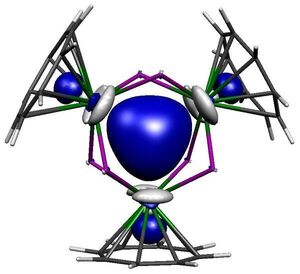
Scientists report breakthrough in actinide metal-metal bonding
"Scientists from The University of Manchester have managed to successfully make actinide metals form molecular actinide-actinide bonds for the first time, opening up a new field of scientific study in materials research. Reported in the journal Nature, a group of scientists from Manchester and Stuttgart universities have successfully prepared and characterised long-sought actinide-actinide bonding in an isolable compound. The majority of the Periodic Table is metals, so the field of metal-metal bonding is a vast area of research after nearly 180 years of investigations, with applications spanning understanding electronic structure, catalysis, chemistry at metal surfaces, magnetism, and bio-inorganic chemistry. Bulk materials can be difficult to study, so there is great interest in studying molecular compounds possessing metal-metal bonding, since such species can be more straightforwardly studied in detail and they constitute models that represent molecular fragments of bulk materials. Though metal-metal bonding is extremely well developed for transition metals and main group elements, which has served as the foundation of the above applications, it has remained virtually unknown for the actinide elements, with examples restricted to spectroscopically observed transients or fundamental diatomics in microscopic-scale trapping experiments. Furthermore, making predictions about elements in the relativistic regime at the foot of the Periodic Table is highly challenging." [...]

Comet ATLAS May Have Been a Blast from the Past
"UMD-led research suggests that a comet seen in 2020 is a remnant of one that crossed the sky during the Stone Age University of Maryland astronomer Quanzhi Ye and colleagues discovered that a comet observed in early 2020 was the remnant of a comet that first streaked through the night sky 5,000 years ago. Their study appeared in The Astronomical Journal on July 21, 2021. Ye and his colleagues identified the ancient source of the comet known as ATLAS (C/2019 Y4) after analyzing observations from the Hubble Space Telescope as the comet disintegrated into a cascade of small icy pieces in mid-2020. Previous analysis revealed that ATLAS followed the same orbital "railroad track" as that of a comet seen in 1844, which means the two comets are probably siblings from a parent comet that broke apart many centuries earlier. Such comet families are common. The most dramatic visual example is the comet Shoemaker-Levy 9 (SL9), which broke into a string of pieces in July 1992 because of Jupiter’s gravitational pull." [...]
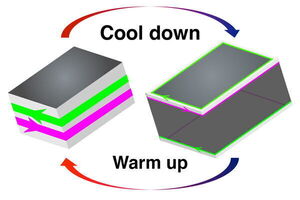
Physicists find room-temperature, 2D-to-1D topological transition
"Rice-led team toggles side- and edge-conduction states in bismuth iodide crystals A Rice University team and its collaborators have discovered a room-temperature transition between 1D and 2D electrical conduction states in topological crystals of bismuth and iodine. Researchers found they could toggle the material, crystalline chains of bismuth iodide (Bi4I4), between low- and high-order conduction states at a transition temperature around 80 degrees Fahrenheit. The research is available online this week in the American Physical Society journal Physical Review X and was conducted by physicists from Rice; the University of Texas at Dallas; the University of California, Berkeley; Ohio State University; and other institutions. Bi4I4 is a topological insulator, a material that’s conductive on its surface or edges but not its interior. The crystal lattice of Bi4I4 undergoes a subtle shift at the transition temperature. The shift changes the material’s electronic behavior, and the study showed this change, or “phase transition,” is the boundary between 1D and 2D topological conduction states." [...]

ITMO Researchers Introduce New Method for Magnetization Switching
"Scientists Andrew Kudlis, Ivan Shelykh, and Ivan Iorsh from ITMO’s School of Physics and Engineering have proposed an innovative method for ultrafast magnetization switching in layered magnetic structures. The developed technique makes it possible to efficiently control memory cells and break the ground for fully optical methods of recording information in 2D materials. The article detailing the results of the study is published in Physical Review B, a peer-reviewed journal of the American Physical Society. Using electron spins for data storage The electron is an elementary particle that has multiple properties, including an electric charge. How can they store information? It’s a well-known fact that capacitors are one type of device that can store electric energy." [...]

Drop the zeros for a performance boost
"An eight-fold speed up of deep machine learning can be achieved by skipping the transmission of zero values. KAUST researchers have found a way to significantly increase the speed of training. Large machine learning models can be trained significantly faster by observing how frequently zero results are produced in distributed machine learning that use large training datasets. AI models develop their “intelligence” by being trained on datasets that have been labelled to tell the model how to differentiate between different inputs and then respond accordingly. The more labelled data that goes in, the better the model becomes at performing whatever task it has been assigned to do. For complex deep learning applications, such as self-driving vehicles, this requires enormous input datasets and very long training times, even when using powerful and expensive highly parallel supercomputing platforms." [...]
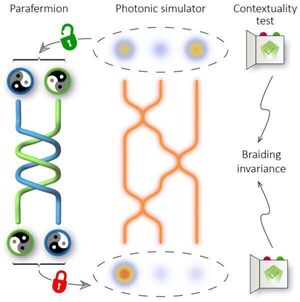
USTC Improves Anyonic Photonic Quantum Simulation
"A research team from University of Science and Technology of China (USTC) led by academician GUO Guangcan, collaborating with Prof. PACHOS Jinannis from University of Leeds, realized topological quantum computation by the braiding of parafermion zero modes and the magic state distillation. This work was published as the Editor's suggestion in PRX Quantum. When two identical bosons or fermions are swapped, their wave function picks up an exchange phase; while in a two-dimensional topological system, peculiar “anyons” are allowed. When two non-Abelian anyons are swapped, their state instead undergoes a very specific unitary evolution. It is possible to construct a fault-tolerant quantum gate by anyonic braiding. However, the existence of Majorana zero mode, one of the most famous non-Abelian anyons, hasn't been proven directly." [...]

BASE demonstrates two-trap cooling
"In a significant technological advance for antimatter research, the BASE (Baryon Antibaryon Symmetry Experiment) collaboration has used laser-cooled ions to cool a proton more quickly and to lower temperatures than is possible using existing methods. The new technique, which introduces a separate Penning trap, promises to reduce the time needed to cool protons and antiprotons to sub-Kelvin temperatures from hours to seconds, potentially increasing the sample sizes available for precision matter-antimatter comparisons by orders of magnitude. As reported today in Nature, the collaboration’s test setup at the University of Mainz also reached temperatures approximately 10 times lower than the limit of the established resistive-cooling technique. “The factor 10 reduction in temperature which has been achieved in our paper is just a first step,” says BASE deputy spokesperson Christian Smorra of the University of Mainz and RIKEN. “With optimised procedures we should be able to reach particle temperatures of order 20 mK to 50 mK, ideally in cooling times of order 10 seconds. Previous methods allowed us to reach 100 mK in 10 hours.” The new setup consists of two Penning traps separated by 9 cm." [...]

New class of habitable exoplanets are 'a big step forward' in the search for life
"A new class of exoplanet very different to our own, but which could support life, has been identified by astronomers, which could greatly accelerate the search for life outside our Solar System. Hycean planets open a whole new avenue in our search for life elsewhere Nikku Madhusudhan In the search for life elsewhere, astronomers have mostly looked for planets of a similar size, mass, temperature and atmospheric composition to Earth. However, astronomers from the University of Cambridge believe there are more promising possibilities out there. The researchers have identified a new class of habitable planets, dubbed ‘Hycean’ planets – ocean-covered planets with hydrogen-rich atmospheres – which are more numerous and observable than Earth-like planets. The researchers say the results, reported in The Astrophysical Journal, could mean that finding biosignatures of life outside our Solar System within the next few years is a real possibility. “Hycean planets open a whole new avenue in our search for life elsewhere,” said Dr Nikku Madhusudhan from Cambridge’s Institute of Astronomy, who led the research." [...]

LED Material Shines Under Strain
"Smartphones, laptops, and lighting applications rely on light-emitting diodes (LEDs) to shine bright. But the brighter these LED technologies shine, the more inefficient they become, releasing more energy as heat instead of light. Now, as reported in the journal Science, a team led by researchers at Lawrence Berkeley National Laboratory (Berkeley Lab) and UC Berkeley has demonstrated an approach for achieving near 100% light-emission efficiency at all brightness levels. Their approach focuses on stretching or compressing a thin semiconductor film in a way that favorably changes its electronic structure. The team identified just how the semiconductor’s electronic structure dictated interaction among the energetic particles within the material. Those particles sometimes collide and annihilate each other, losing energy as heat instead of emitting light in the process." [...]
Harnessing the particle-tracking power of the algorithm
"A simple camera system paired with a sophisticated image-processing algorithm can achieve faster and more accurate reconstructions of particle flow. By replacing a complex hardware setup with simple hardware paired with optimized image processing, researchers from KAUST have developed a faster and more accurate three-dimensional (3D) particle-tracking system. Observing the 3D motion of particles in flow is important in studies of aerodynamics, fluid flow and molecular dynamics. Conventionally, this is performed using a complicated arrangement of multiple cameras, the images from which are analyzed and compared to reconstruct the motion of individual particles in 3D space over time. However, due to the complexity of the setup and the need for frequent and finicky calibration, such 3D particle velocimetry systems are often large, expensive and difficult to use. Holography offers a promising simpler alternative." [...]

Playing with proteins
"At the MIT Edgerton Center, educators are quietly transforming the way biology is taught in schools. It’s a cloudy July afternoon in Cambridge, Massachusetts, and MIT Edgerton Center Instructor Amanda Mayer is using brightly-colored plastic to build proteins. She takes a small yellow block and moves it to the end of a chain of blue and green ones, clicking it into place. “Congratulations,” she says to the four high school students guiding her hand over Zoom. “You’ve all become synthetic biologists.” Together, the group has assembled a model of the complex molecules found in their food and bodies. “I used to think proteins were just one thing,” says a high school student named Fatima, who has the same blocks laid out before her at home." [...]
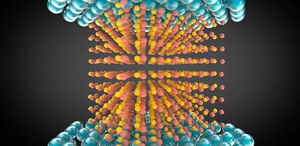
Keeping it random
"A nano-scale memristor is shown to have superior stability for random number generation as an integral part of secure data transmission. Using atomically thin two-dimensional films, researchers have developed a nano-scale random number generator with enhanced long-term stability and reduced power consumption. Random number generation is a critical underlying function of secure data transmission, used to encrypt and secure data and generate one-time passwords. To generate a random number, a circuit detects the random noise produced by a physical component, such as the thermal noise from diodes or resistors. However, the power consumption of these elements can be significant in highly integrated low-power applications, and the degree of randomness can degrade over time due to a change in the device’s physical and electronic characteristics. Mario Lanza, who joined KAUST in 2020, saw an opportunity for nano-scale devices called memristors to be used as more reliable true random number generators (TRNGs)." [...]

Breakthrough in sizing nanoparticles using fluid-filled tubes
"The functionality of nanoparticles in a host of applications, including drug delivery and nano-optics, is often dictated by their mass and size. Measuring these properties simultaneously for the same nanoparticle has also been challenging. Now scientists from the University of Melbourne and Massachusetts Institute of Technology (MIT) have discovered that this measurement feat can be performed by passing the nanoparticles, in their native solution, through an inexpensive and simple mechanical tube. In a paper released today in Nature Communications researchers detail how they made the discovery using existing instrumentation and new mathematics. Simple mass balances work by tracking the frequency of a mechanical resonator. But can these balances be used to also measure size?" [...]
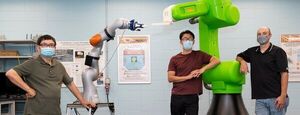
These robots can move your couch
"To train robots how to work independently but cooperatively, researchers at the University of Cincinnati gave them a relatable task: move a couch. If you’ve ever helped someone move furniture, you know it takes coordination — simultaneously pushing or pulling and reacting based on what your helper is doing. That makes it an ideal problem to examine collaboration between robots, said Andrew Barth, a doctoral student in UC’s College of Engineering and Applied Science. “It’s a good metaphor for cooperation,” Barth said. In the Intelligent Robotics and Autonomous Systems Lab of UC aerospace engineering professor Ou Ma, student researchers developed artificial intelligence to train robots to work together to move a couch — or in this case a long rod that served as a stand-in — around two obstacles and through a narrow door in computer simulations. “We made it a little more difficult on ourselves." [...]
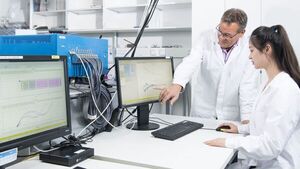
Record-breaking Lithium-metal Cell
"A new type of lithium-metal battery reaches an extremely high energy density of 560 watt-hours per kilogram – based on the total weight of the active materials – with a remarkable stability. Researchers of the Helmholtz Institute Ulm (HIU) of Karlsruhe Institute of Technology (KIT) used a promising combination of cathode and electrolyte: The nickel-rich cathode enables storage of high energy per mass, the ionic liquid electrolyte ensures largely stable capacity over many cycles. This is reported by the scientists in Joule (DOI: 10.1016/j.joule.2021.06.014). Currently, lithium-ion batteries represent the most common solution for mobile power supply. In some applications, however, this technology reaches its limits. This especially holds for electric mobility, where lightweight and compact vehicles with large ranges are desired." [...]
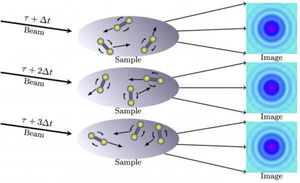
CAMERA Mathematicians Build an Algorithm to ‘Do the Twist’
"New Approach Extracts Rotational Diffusion from X-ray Photon Correlation Spectroscopy Experiments Mathematicians at the Center for Advanced Mathematics for Energy Research Applications (CAMERA) at Lawrence Berkeley National Laboratory (Berkeley Lab) have developed a mathematical algorithm to decipher the rotational dynamics of twisting particles in large complex systems from the X-ray scattering patterns observed in highly sophisticated X-ray photon correlation spectroscopy (XPCS) experiments. These experiments — designed to study the properties of suspensions and solutions of colloids, macromolecules and polymers — have been established as key scientific drivers to many of the ongoing coherent light source upgrades occurring within the U.S. Department of Energy (DOE). The new mathematical methods, developed by the CAMERA team of Zixi Hu, Jeffrey Donatelli, and James Sethian, have the potential to reveal far more information about the function and properties of complex materials than was previously possible. Particles in a suspension undergo Brownian motion, jiggling around as they move (translate) and spin (rotate). The sizes of these random fluctuations depend on the shape and structure of the materials and contain information about dynamics, with applications across molecular biology, drug discovery, and materials science. XPCS works by focusing a coherent beam of X-rays to capture light scattered off of particles in suspension." [...]
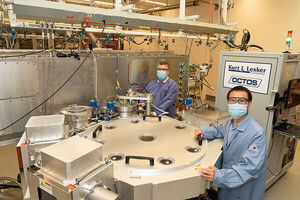
Layered Graphene with a Twist Displays Unique Quantum Confinement in 2-D
"Understanding how electrons move in 2-D layered material systems could lead to advances in quantum computing and communication Scientists studying two different configurations of bilayer graphene—the two-dimensional (2-D), atom-thin form of carbon—have detected electronic and optical interlayer resonances. In these resonant states, electrons bounce back and forth between the two atomic planes in the 2-D interface at the same frequency. By characterizing these states, they found that twisting one of the graphene layers by 30 degrees relative to the other, instead of stacking the layers directly on top of each other, shifts the resonance to a lower energy. From this result, just published in Physical Review Letters, they deduced that the distance between the two layers increased significantly in the twisted configuration, compared to the stacked one. When this distance changes, so do the interlayer interactions, influencing how electrons move in the bilayer system. An understanding of this electron motion could inform the design of future quantum technologies for more powerful computing and more secure communication." [...]

High-rate Magnesium Rechargeable Batteries Move One Step Closer to Realization
"Magnesium rechargeable batteries (MRBs), where high-capacity Mg metal is used as the anode material, are promising candidates for next-generation batteries due to their energy density, safety, and cost. However, the lack of high-performance cathode materials impedes their development. Like their lithium-ion counterparts, transition metal oxides are the staple cathode materials in MRBs. Yet the slow diffusion of Mg ions inside the oxides poses a serious problem. To overcome this, some researchers have explored sulfur-based materials. But sulfur-based cathodes for MRBs have severe limitations: low electronic conductivity, sluggish Mg diffusion in solid Mg-S compounds, and dissolubility of polysulfides into electrolytes, which results in low-rate capability and poor cyclability." [...]

One material with two functions could lead to faster memory
"Researchers use perovskite to develop a memory device readable through both electrical and optical methods In a step toward a future of higher performance memory devices, researchers from National Taiwan Normal University and Kyushu University have developed a new device that needs only a single semiconductor known as perovskite to simultaneously store and visually transmit data. By integrating a light-emitting electrochemical cell with a resistive random-access memory that are both based on perovskite, the team achieved parallel and synchronous reading of data both electrically and optically in a ‘light-emitting memory.’ At the most fundamental level, digital data is stored as a basic unit of information known as a bit, which is often represented as either a one or a zero. Thus, the pursuit of better data storage comes down to finding more efficient ways to store and read these ones and zeros. While flash memory has become extremely popular, researchers have been searching for alternatives that could further improve speed and simplify fabrication. One candidate is nonvolatile resistive random-access memory, or RRAM. Instead of storing charge in transistors like in flash memory, resistive memory uses materials that can switch between states of high and low resistance to represent ones and zeros." [...]
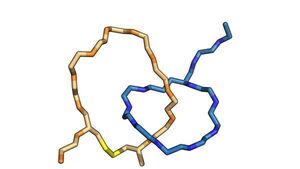
Researchers invent world's smallest biomechanical linkage
"Researchers at Princeton University have built the world's smallest mechanically interlocked biological structure, a deceptively simple two-ring chain made from tiny strands of amino acids called peptides. In a paper published August 23 in Nature Chemistry, the team detailed a library of such structures made in their lab—two interlocked rings, a ring on a dumbbell, a daisy chain and an interlocked double lasso—each around one billionth of a meter in size. The study also demonstrates that some of these structures can toggle between at least two shapes, laying the groundwork for a biomolecular switch. "We've been able to build a bunch of structures that no one's been able to build before," said A. James Link, professor of chemical and biological engineering, the study's principal investigator. "These are the smallest threaded or interlocking structures you can make out of peptides." To craft these gadgets, dubbed mechanically interlocked peptides, or MIPs, the researchers used genetic engineering to manipulate individual amino acids in a naturally occurring lasso peptide, microcin J25, and direct the peptide to self-assemble into new shapes." [...]
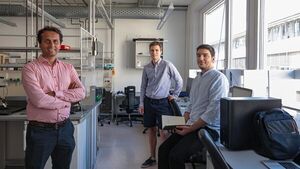
LiftPose3D: Turning 2D images into 3D models
"EPFL scientists have developed a deep learning-based method called LiftPose3D, which can reconstruct 3D animal poses using only 2D poses from one camera. This method will have impact in neuroscience and bioinspired robotics. “When people perform experiments in neuroscience they have to make precise measurements of behavior,” says Professor Pavan Ramdya at EPFL’s School of Life Sciences, who led the study. His group has now published a paper in Nature Methodspresenting new software that can simplify one of neuroscience’s most crucial yet laborious tasks: capturing 3D models of freely moving animals. This tool allows them to study the brain mechanisms controlling body movements. This goal of reverse-engineering biological behavior has far-reaching applications in robotics and AI." [...]

New sensor can detect valuable rare earth element in non-traditional sources
"Low concentrations of terbium could be identified from acid mine drainage and other waste sources A new luminescent sensor can detect terbium, a valuable rare earth element, from complex environmental samples like acid mine waste. The sensor, developed by researchers at Penn State, takes advantage of a protein that very specifically binds to rare earth elements and could be harnessed to help develop a domestic supply of these metals, which are used in technologies such as smart phones, electric car batteries, and energy efficient lighting. A paper describing the sensor appears Aug. 25 in the Journal of the American Chemical Society. Terbium, one of the rarest of the rare earth elements, produces the green color in cell phone displays and is also used in high-efficiency lighting and solid-state devices. However, there are a variety of chemical, environmental and political challenges to obtaining terbium and other rare earth elements from the environment. Developing new sources of these metals also requires robust detection methods, which poses another challenge." [...]

New quantum 'stopwatch' can improve imaging technologies
"Researchers at CU Boulder have designed one of the most precise stopwatches yet—not for timing Olympic sprinters and swimmers but for counting single photons, or the tiny packets of energy that make up light. The team’s invention could lead to big improvements in a range of imaging technologies—from sensors that map out entire forests and mountain ranges to more detailed devices that can diagnose human diseases like Alzheimer's and cancer. The group published its results this week in the journal Optica. Bowen Li, lead author of the new study, said that the research focuses on a widely-applied technology called time-correlated single photon counting (TCSPC). It works a bit like the timers you see at the Olympics: Scientists first shine a laser light at a sample of their choice, from individual proteins all the way up to a massive geologic formation, then record the photons that bounce back to them. The more photons researchers collect, the more they can learn about that object." [...]

ANU scientists set new record with bifacial solar cells
"Scientists at The Australian National University (ANU) have produced a more efficient type of solar cell, using laser processing and setting a new world record in the process. The solar cells are dual sided, meaning both the front and back of the cell generate power. Principal Investigator Dr Kean Chern Fong said the so called bifacial solar cells easily beat the performance of single sided silicon solar cells. "We have developed what I would call a true bifacial solar cell, as it has nearly symmetrical power generation capacity on both surfaces of the device," Dr Fong said. "When deployed on a conventional solar farm, a bifacial cell absorbs direct incoming light, while also taking advantage of ground reflection, which can contribute up to additional 30 per cent power generation. "Bifacial solar cells are becoming increasingly important in the roll out of solar farms and are expected to have a market share of over 50 per cent in the next five years." [...]

This Technology Could Bring the Fastest Version of 5G to Your Home and Workplace
"Consumers of today’s 5G cellphones may have experienced one of the following tradeoffs: impressive download speeds with extremely limited and spotty coverage, or widespread and reliable coverage with speeds that aren’t much faster than today’s 4G networks. A new technology developed by electrical engineers at the University of California San Diego combines the best of both worlds and could enable 5G connectivity that is ultra-fast and reliable at the same time. The team will present their work at the ACM SIGCOMM 2021 conference which will take place online Aug. 23 to 27. The technology presents a solution to overcome a roadblock to making high band 5G practical for the everyday user: the speedy wireless signals, known as millimeter waves, cannot travel far and are easily blocked by walls, people, trees and other obstacles. Today’s high band 5G systems communicate data by sending one laser-like millimeter wave beam between a base station and a receiver—for example, a user’s phone. The problem is if something or someone gets in the way of that beam’s path, then the connection gets blocked completely." [...]
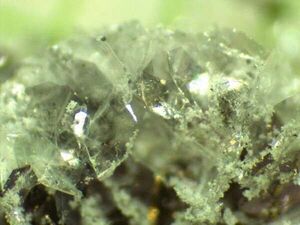
One scientist’s trash is another’s treasure: A laboratory’s “irritating” byproduct now supplies 2-D materials research
"While making materials samples to pursue their own research goals, scientists at the U.S. Department of Energy’s Ames Laboratory discovered that an unwanted byproduct of their experiments was an extremely high-quality and difficult-to-obtain substance sought after by scientists researching layered materials. With a project name like “Complex States, Emergent Phenomena & Superconductivity in Intermetallic and Metal-like Compounds” one immediately senses that the team of scientists behind that title might have a knack for the weird, unusual, and never-before-seen. The Ames Lab group investigates metallic and semi-metallic compounds that have magnetic, superconducting, or other properties that are designed to probe the fundamental mysteries of how correlated or emergent states can form and, also, might be useful in future tech applications, such as energy creation, transmission and storage as well as quantum computing. But before they can investigate the weird, unusual, and never-before-seen, they have to make it-- so the team has decades of expertise in creating those materials as well. One focus of the group’s research is MgB2, a difficult to produce superconducting material. So difficult, in fact, that the tool used to make it is called “The Beast.” Lurking in the basement of Ames Laboratory’s Spedding Hall, the Beast is a finicky, powerful, and giant high-pressure furnace that super-heats and super-squashes tiny amounts of hard-to-combine ingredients together into new compounds." [...]

New Study Unveils Thermoelectric Ink that Turns Car Exhaust Pipes into Power Generators
"A joint research team, affiliated with UNIST has announced that they have successfully developed a thermoelectric technology to produce power-generating tubes using 3D printing techniques. Researchers found that the tube-shaped device is more effective than conventional devices. This breakthrough has been jointly led by Professor Han Gi Chae and Professor Jae Sung Son from the Department of Materials Science and Engineering, and Professor Sung Youb Kim from the Department of Mechanical Engineering at UNIST. “Through this research, we will be able to effectively convert heat generated by factory chimneys, the most common type of waste heat source, into electricity,” said Professor Son. He said this is because the existing thermoelectric devices were in rectangular parallelepiped shapes. In this study, researchers created the thermoelectric tube using a 3D printed ink made of lead (Pb) and tellurium (Te)." [...]
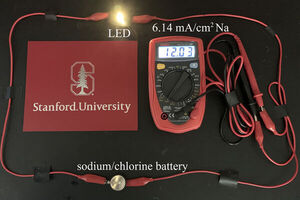
Stanford researchers make rechargeable batteries that store six times more charge
"A new type of rechargeable alkali metal-chlorine battery developed at Stanford holds six times more electricity than the commercially available rechargeable lithium-ion batteries commonly used today. An international team of researchers led by Stanford University has developed rechargeable batteries that can store up to six times more charge than ones that are currently commercially available. The advance, detailed in a new paper published Aug. 25 in the journal Nature, could accelerate the use of rechargeable batteries and puts battery researchers one step closer toward achieving two top stated goals of their field: creating a high-performance rechargeable battery that could enable cellphones to be charged only once a week instead of daily and electric vehicles that can travel six times farther without a recharge. The new so-called alkali metal-chlorine batteries, developed by a team of researchers led by Stanford chemistry Professor Hongjie Dai and doctoral candidate Guanzhou Zhu, relies on the back-and-forth chemical conversion of sodium chloride (Na/Cl2) or lithium chloride (Li/Cl2) to chlorine. When electrons travel from one side of a rechargeable battery to the other, recharging reverts the chemistry back to its original state to await another use. Non-rechargeable batteries have no such luck." [...]
Documentação
A documentação é parte essencial do processo de aprendizagem e a Internet além de artigos interessantes de explorar também tem alguma documentação em formato PDF interessante de ler. Todos os links aqui apresentados são para conteúdo disponibilizado livremente pelo editor do livro.
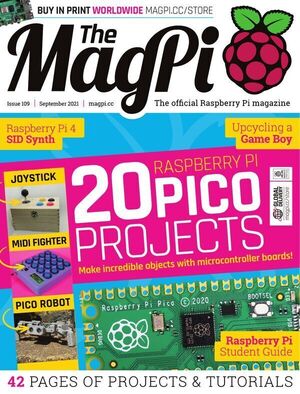
The MagPi 109
"Inside The MagPi magazine #109 - 20 Raspberry Pi Pico projects. The best ideas for new builds using your microcontroller board. - Automated model railroad. How one maker is using Raspberry Pi to control a model railroad. - Creating a SID-based synthesizer. Using multiple sound chips from the Commodore 64 to build a synth like no other." [...]

Learning MongoDB
"Data in the world started to grow tremendously after mobile application came in the market. This huge amount of data became almost impossible to handle with traditional relational database - SQL. NoSQL databases are introduced to handle those data where much more flexibility came like variable number of columns for each data. MongoDB is one of the leading NoSQL databases. Each collection contains a number of JSON documents. Any data model that can be expressed in a JSON document can be easily stored in MongoDB." [...]
Projetos Maker
Diversos Projetos interessantes.

Smart Indoor Harvesting Using Wio Terminal & Blynk
"Cloud connected, fully automated, smart indoor herb harvesting using Seeed Studio's Wio Terminal and Blynk app. This project is basically designed and programmed by my daughter with little help from me. She participated in 2021 do-your-bit contest where she prototyped indoor plant harvesting system using Micro:bit. Since then, she was asking me how enhance her project so that she can control certain things in a smarter way. I suggested her to use Wio Terminal for some obvious reasons. 1." [...]

Bootloader PIC18F2550
"Build a bootloader board with the PIC18F2550, which you will able to program your microcontroller directly from your PC to the board. This is a small board which use the well know Pic18F2550, this microcontroller is easy to find in the electronic stores and most of the electronics hobbyist have one of them in their stock. So in this opportunite We are going to build a develpment board, which means that will have all the neccesary to work and test our codes and projects. MAIN FEATURES - USB support is the most important feature of self PIC 18f2550; you can have a quick communication with your computer via USB - Power Led: indicates whether the + 5v USB Supply - Push button integrated for reset - Very affordable to find the componets - Programming by a small aplication from our PCB - Interfacing via USB HID (Human interface devide)" [...]

P-CNC Laser Engraver and Pen Plotter
"In this project, I'd like to share how to build a homemade 3 axis P-CNC machine with its frame and supports made of PVC pipes and acrylic sheets. It has two operation modes: pen plotting and laser engraving. 1. Main materials: 1pcs x 3 Axis Control Board GRBL With Laser Engraver Supported. 1pcs x 2500mW Laser Module. 3pcs x Stepper Motor Driver A4988." [...]

8 Channel RC Servo Driver Over RF Link using NRF24L01 RF Module – Arduino Compatible
"This is an easy-to-build open-source Arduino compatible board that enables driving 8 RC servos over NRF24L01 RF Link. The project can be used as a standalone RC servo driver or 8 channel RF remote-controlled RC servo Receiver. An optional OLED display option can be used to develop RC signal monitor. The tiny module contains an ATmega328 microcontroller, connectors for 8 x Servo interface, DC supply connector, bulk electrolytic capacitor C5 on DC supply to provide jitter-free smooth movement of RC servos. Operating Supply 5V DC. This board is compatible with our Dual Joystick RF Remote Transmitter with NRF24L01 RF module or Single Joystick Remote Control Transmitter using NRF24L01 as the transmitter." [...]

Dual Joystick RF Remote Transmitter with NRF24L01 RF module – 2 Joystick Control
"This is an Arduino compatible open-source hardware that includes 2 x Joysticks, NRF24L01 RF module, Atmega328 microcontroller, 3.3V regulator, power LED, function LED, Arduino programming connector, and other required components. This board can be used for the development of various applications such as Gaming, Remote RC servo driver, Robotics, and many more. Connector CN3 was provided to program the ATMEGA328 microcontroller using Arduino IDE. The project is compatible with our 8 Channel RC Servo Driver Over RF Link using NRF24L01 RF Module as the receiver or the DC Motor Speed, Direction and Brake Control with NRF24L01 RF Module. The user will be able to drive 4 RC servos with this transmitter or a DC motor respectivelly. " [...]
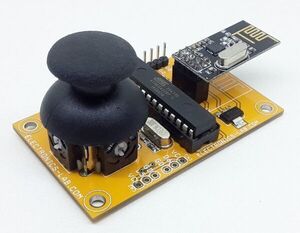
Single Joystick Remote Control Transmitter using NRF24L01 – Arduino Compatible
"This is an Arduino compatible open-source hardware that includes 1 x joystick, NRF24L01 RF module, Atmega328D microcontroller, 3.3V regulator, power LED, function LED, and other required components. This board can be used for the development of various applications such as Gaming, Remote RC servo driver, RC Motor controller, Robotics, and many more. Arduino Code is available for testing purposes and the project works as a transmitter and drives DC motor controller board with this code. The project is compatible with our DC Motor speed and direction controller board, and 8 Channel RC Servo Board. " [...]
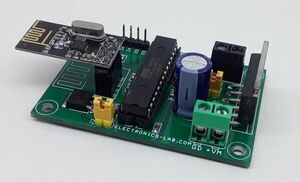
DC Motor Speed, Direction and Brake Control with NRF24L01 RF Module – Arduino Compatible
"This is Arduino compatible hardware that can control a single DC motor speed, direction, and brake using an RF remote control. The project is based on an ATMEGA328 microcontroller, H-Bridge DC motor driver chip LM18201, NRF24L01 RF module, 5V Regulator, 3.3V regulator and other components. This board can drive a DC Motor up to 24V DC with a load current up to 3A. Arduino pin configuration details are provided below, the user may write their own code and use this hardware. The ATMEGA328 is the heart of the project, the LMD18201 chip drives the motor, LM317-ADJ provides 5V to the microcontroller, LM1117 3.3V regulator power the 3.3V to NRF24L01. " [...]

mRNA vaccine badge
"A small badge showing a schematic of an mRNA vaccine nanoparticle and blinking the RNA sequence of the Moderna or Pfizer vaccines. (Switch between vaccines by long pressing (>1s) the button to enter the menu, short pressing to switch, and long pressing to save). The RNA for the moderna vaccine is from is from https://github.com/NAalytics/Assemblies-of-putative-SARS-CoV2-spike-encoding-mRNA-sequences-for-vaccines-BNT-162b2-and-mRNA-1273 with an added poly-A tail of similar length to the Pfizer one (just a guess). The Pfizer sequence is from https://berthub.eu/articles/11889.doc The sequences are stored encoded into 2 bits per nucleotide using encode_genome.py. Current draw is ~3mA depending on which color LEDs are active at the moment (the blue ones are a lot more efficient than the red ones). A CR2032 coin cell should last for at least 10h of continuous use (one run through the sequence takes ~10min, and it automatically shuts off afterwards)." [...]
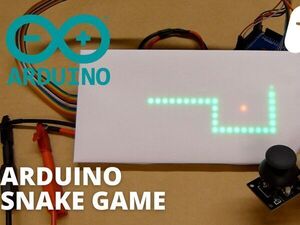
Arduino Snake Game with 32x16 LED Panel
"Let's play Snake! We use an Arduino, a 32x16 LED Panel and a joystick. We are going to program, make and of course play the famous Snake Game ourselves! Everything is nicely explained in the video below. Connect all components according to the diagram at the bottom of this page. " [...]

Arduino Drum Lessons
"Let's teach Arduino some drum lessons! We're using an Arduino, a servo motor and a sound sensor. We are going to give Arduino some drum lessons. " [...]

RGB LED Etch-A-Sketch
"A modern take on an old classic -- create colour pixel art by turning two rotary encoders to control the horizontal and vertical position of the cursor, click to change colour. All controlled by an Arduino Nano. How it works - Turning the left encoder moves the cursor left and right. Pressing it cycles forward through an array of eight colours - Turning the right encoder moves the cursor up and down. Pressing it cycles backwards through the array of colours - When you move the cursor, the selected colour remains in the previous 'pixel' - The cursor is shown brighter than the other pixels so users can see where it is. Electronics Arduino Nano 2 x rotary encoders with push-switch 2 x white knobs for encoders WS2812b 16 x 16 LED matrix Proto board (just a couple of small strips) 15 x Jumpers Secondary power source for WS1812b matrix (recommended, but I haven't used) Case MDF / wood PVA glue Red paint Hot glue" [...]
Solar Tracker 35W with DC Motors
"Solar tracking photovoltaic (dual axis) that follows the sun, using LDR sensors and two DC motors. This project is designed for educational purposes. It will be used for demonstration to students in order to have a first touch with solar trackers and photovoltaics. The project is related to renewable energy and specifically photovoltaics. A dual axis solar tracker with photovoltaic was designed in order to follow the sun during the day. Photovoltaic powers the solar tracker (no external source needed)." [...]

XpandShield MK1
"An Arduino Shield with extensive I/O that is compatible with many Arduino boards. Follows Arduboy pinout. This shield, to the end of the day, is the extension of the old LCD4884 Joystick Shield. However, whereas the LCD4884 Shield may be compatiable with Arduino Uno, this shield is not. For the Uno is "physically incapable" of the shield's needs, for because the Uno, the ATMega328p, however "original" it is, seem to only be a former shadow of itself. In part, the digital pins 9, 10, 11 is copies of pins off the ICSP header." [...]
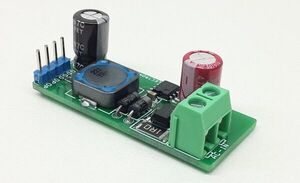
230V AC Input – 12V Output DC Converter, Non-Isolated Buck Converter
"The project described here outputs 12V DC voltage from the input of 230V AC. The output current is up to 100mA. The project is based on BM2P129TF chip which is PWM method DC/DC converter with a built-in 650V MOSFET. BM2P129TF contributes to low power consumption by built-in a 650V starting circuit. Built-in current detection resistor realizes compact power supply design. Current mode control imposes current limitation on every cycle, providing superior performance in bandwidth and transient response." [...]

Battery Life Cycle Predictor Powered by Edge Impulse
"A TinyML model to predict the Lithium Ion battery's life cycle within shorter time using Edge Impulse. To predict the Life cycle of Lithium Ion battery, there are many methods are available. one of the common method is by linear interpolating the discharge capacity to the life cycle. In a conventional method, To estimate the life cycle using discharge capacity method, it takes 2 hours 30 mins of time for 2500mAh - single Lithium Ion cell. " [...]

Leukemia Detection with NVIDIA Jetson Nano
"Acute Lymphoblastic Leukemia Detection on the NVIDIA Jetson Nano. The Acute Lymphoblastic Leukemia Jetson Nano Classifier is a Convolutional Neural Network (CNN) developed using Intel® oneAPI AI Analytics Toolkit and Intel® Optimization for Tensorflow* to accelerate the training process, and TensorRT for high performance inference on the NVIDIA® Jetson Nano™. In this project you will do the following. - Train a custom CNN for Acute Lymphoblastic Leukemia on your development machine. - Convert the Tensorflow SavedModel to TFRT format - Convert the Tensorflow SavedModel to ONNX format - Convert the Tensorflow ONNX model to TensorRT format - Test the CNN on your development machine. - Download or create a custom docker container for your NVIDIA Jetson Nano." [...]

Universal Logic Probe
"These days good quality oscilloscope is not an expensive instrument and, we can see it in most workbenches. With the advancement of oscilloscopes, simple testing tools such as logic probes are not as popular these days. However, if the oscilloscope or logic analyzer was out of reach, the logic probe is a handy instrument to check digital circuits. Also, in some cases, a logic probe is an easy option to check the functionality of low-speed logic circuits because it provides a real-time visual indication of the logic state without adjustments or calibrations. The logic probe design described in this article uses common and inexpensive ICs, including the popular NE555 timer and LM393 low voltage comparator IC. At the time of this writing, both ICs were prevalent in the market and cost less than US$ 0.25." [...]

Make Your Own Curie Pendulum (Heat Engine)
"Hello fellow makers, Today I would like to show you how I made this Curie pendulum. This is a simple curie effect heat engine and is a great way to demonstrate this important scientific principle. The curie effect usually refers to a magnetic phenomenon discovered by Pierre Curie. He discovered that ferromagnetic substances exhibited a critical temperature transition, above which the substances lost their ferromagnetic behavior. This is now known as the curie point. When our pendulum that is heated by a candle reaches its curie point it is no longer attracted by the magnet and swings out of the flame, now out of the flame the pendulum cools down and is attracted by the magnet again." [...]

MutantC V4 - Easy to Build, Modular Handheld PC
"A small Handheld PC with a physical 56 key keyboard, 4inch Display and Expansion header for add-on boards (Like Arduino Shield). Here we will discusses what you need to build one and show step by step guide. This device is very easy to make, you don't need lots of tools and parts. No codding skill is needed. just basic stuff like upload a code to Arduino, little skill in Linux CMD line to install the driver. Little soldering skill that's all." [...]
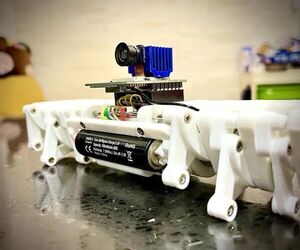
Strider Camera Robot
"This Instructables show how to use ESP32-CAM and 3D printed parts build a Strider Camera Robot. " [...]

Roamer, the Self Charging Companion Robot
"Initially, set Roamer on a charging station. She will wander around, feed herself and rest at night. The next day, shell do it again. The charging station is merely a metal plate and a pole with metal foil attached to a bench power supply. To me, a personal companion robot should have the functionality of an ant or better: no programming, setting controls or recharging batteries. Roamer can run about 20 minutes between charges." [...]

RaspberryPi Pico Web Server w W5100S(W5500) - NeoPixel LED
"HOWTO: make a Simple web server project with RaspberryPi Pico & W5100S(W5500). Let's control NeoPixel LED via webpage. CircuitPython Env!! In the RaspberryPi Pico SIMPLE web server RGB LED control project we will use an WIZnet W5100S, WIZ810Sio and we will create a small http web server on our Ethernet LAN which will control an RGB LED with an interactive web interface. " [...]

Raspberry Pi Temperature and CO2 Monitor
"Measure and display air quality with the Raspberry Pi. This project is ideal if you already have a Raspberry Pi running 24/7, e.g., as web server, printer server, pi-hole etc. Then you can easily add extra functionality like air monitoring, which will be achieved by realizing this project. At the end, you will have a small status screen displaying temperature, humidity, TVOC and CO2 values. Requirements To follow this guide, you need a Raspberry Pi. I used the Model 3, but any other model should work fine too." [...]
Secção Videos
Videos interessantes.
That's all Folks!








